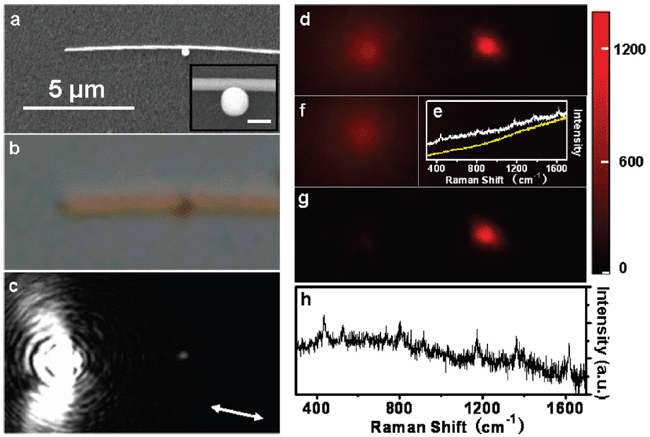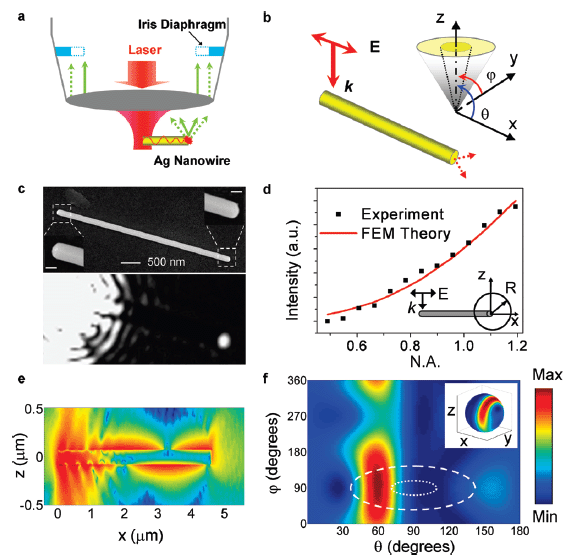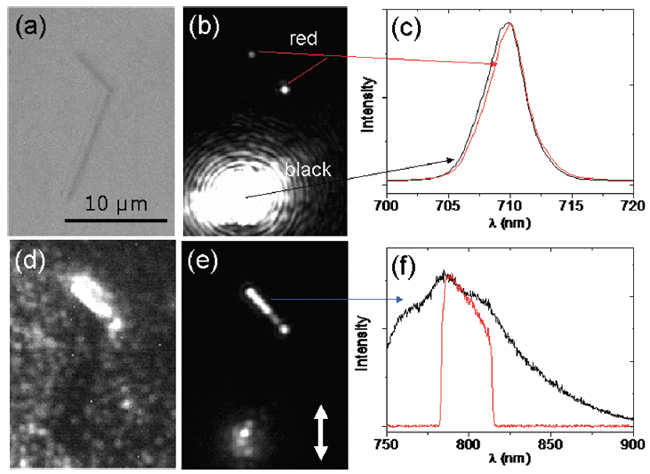Photon, as the information carrier, has great advantages, for instance, large band width, high density, high speed, low damping. Half of the Nobel Prize for Physics in 2009 is given to Professor Charles Kao for his groundbreaking achievements concerning the transmission of light in fibers for optical communication. However, diffraction limit is an obstacle for the miniaturization of optical devices and chips. In recent years, surface plasmons (SPs), collective oscillations of free electron gas at the interface of metal and dielectric, attract the researchers’ attention since SPs can break the diffraction limit of light. The manipulation of light at the nanometer scale brings the promise for the miniaturization of optical elements and chips. And the research on surface plasmons has become a rapidly growing field, i.e. Plasmonics.
The research group led by Professor Hongxing Xu in Institute of Physics, Chinese Academy of Sciences has been working in this area for a few years, and performed systematic studies on the manipulation of light intensity, polarization, propagation and optical force at the nanometer scale. Prof. Xu and his colleagues discovered the huge electromagnetic field enhancement in the nanogaps between metal nanoparticles (Phys. Rev. Lett. 83, 4357 (1999), Phys. Rev. E 62, 4318, (2000)), which is the foundation for surface-enhanced spectroscopy and some other nonlinear effects. The researches developed based on this work become the contents of one session in the 2010 March meeting of American Physical Society (Z2: Plasmonic nanogaps). In the recent two years, they studied a few different metal nanostructure systems, including nanohole-nanoparticle, nanowire-nanoparticle, scanning tunneling microscope (STM) tip-nanoparticle, nanorice, nanoflowers, etc., and some results have been published (Small 4, 1296 (2008); Nano Lett. 8, 2497 (2008); APL 92, 093110 (2008); JACS 131, 6068 (2009); Adv. Mater. 21, 4614 (2009)).
The control of light propagation at the nanometer scale is critical for the development of nanophotonic chips and novel sensors, and is a hot research topic in the field of Plasmonics all over the world. Recently, Prof. Xu’s group made important progresses in the study of surface plasmon propogation. The PhD student Yurui Fang and Dr Hong Wei achieved remote-excitation surface-enhanced Raman scattering (SERS) at the single molecule level. They collaborated with Prof. Peter Nordlander in Rice University in US, and explained theoretically the mechanism of remote-excitation SERS. The novel technique for performing SERS using propagating surface plasmons as a remote excitation source has remarkable advantages compared with direct optical excitation. Remote-excitation can achieve the illumination within micrometer area, and thus improve the signal to noise ratio and decrease the damage to the samples. This approach allows for remote-excitation SERS sensing and has great potential to expand ultrasensitive chemical detection to new systems. The multisite sensing capability could be very useful in a variety of contexts from probing complex molecular processes in intracellular environments to studying the propagation characteristics of plasmon waves themselves on nanowires or other nanoscale structures. It may even be useful for constructing complex plasmonic networks, where the junction between nanowire and nanoparticle would serve as a node. Such possibilities could greatly expand the use of surface plasmons for local communications and information transfer at submicrometer length scales. This work is published on Nano Letters 9, 2049 (2009).
Dr Zhipeng Li and coworkers in Prof. Xu’s group studied the surface plasmon propagation in Ag nanowires. They have observed that light from the end of a silver nanowire, following excitation of plasmons at the other end of the wire, is emitted in a cone of angles peaking at nominally 45-60° from the nanowire axis, with virtually no light emitted along the direction of the nanowire. They collaborated with Prof. Peter Nordlander in Rice University in US, and explained this surprising characteristic in a simple picture invoking Fabry-Pérot resonances of the forward- and back-propagating plasmons on the nanowire. This strongly angular-dependent emission is a critical property that must be considered when designing coupled nanowire-based photonic devices and systems. This work is published on Nano Letters 9, 4383 (2009).
Dr Hong Wei in this group studied propagating surface plasmon induced photon emission from quantum dots, collaborated with Prof. Chih-Kang Shih et al in University of Texas at Austin. They found that propagating surface plasmons can excite excitons, which results in quantum dot emission. In this process, the energy is directly transferred from the propagating surface plasmons to the excitons without converting to photons. Furthermore, they demonstrate the reverse process where the decay of excitons generates surface plasmons. This work is published on Nano Letters 9, 4168 (2009).
The authors acknowledge financial supports from NSFC, MOST and CAS.
 |
| Figure 1. Remote-excitation surface-enhanced Raman scattering (SERS) of MGITC molecules excited through propagating plasmons. |
 |
| Figure 2. Angular emission measurement in Ag nanowires. |
 |
| Figure 3. Propagating Surface Plasmon Induced Photon Emission from Quantum Dots. |




